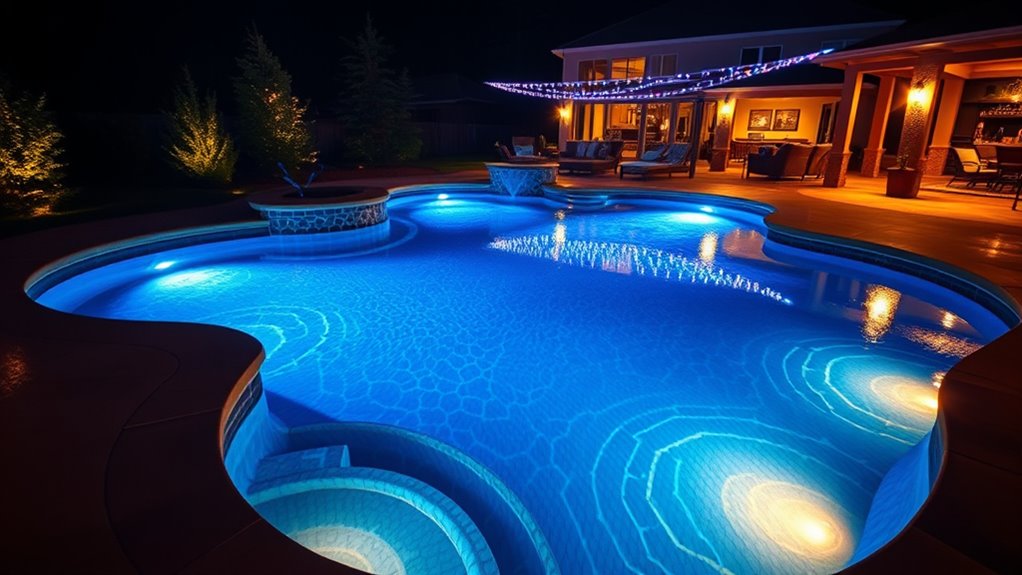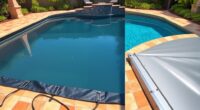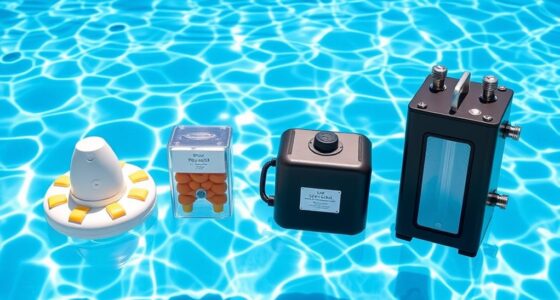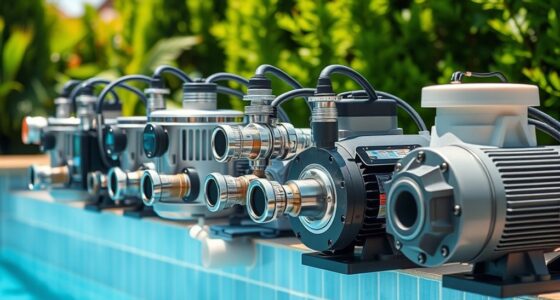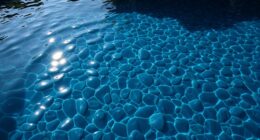When choosing pool lighting options, you can opt for LED lights for vibrant colors and energy savings, fiber optic lights for sleek, customizable effects, or halogen lights for warm, simple illumination at a lower cost. LEDs are versatile and eco-friendly, while fiber optics offer a modern, magical touch, and halogen provides a straightforward solution. To find the best fit for your pool’s ambiance and budget, explore these options further.
Key Takeaways
- LED pool lighting offers customizable colors, energy efficiency, and long lifespan for versatile ambiance.
- Fiber optic lights create vibrant, modern effects with sleek design and minimal heat, ideal for unique pool aesthetics.
- Halogen lights provide warm, bright illumination at a lower upfront cost but have shorter lifespan and higher energy use.
- Installation complexity varies, with fiber optics being more involved, while LEDs and halogens are generally simpler.
- Choose based on desired ambiance, energy savings, maintenance, and budget considerations.
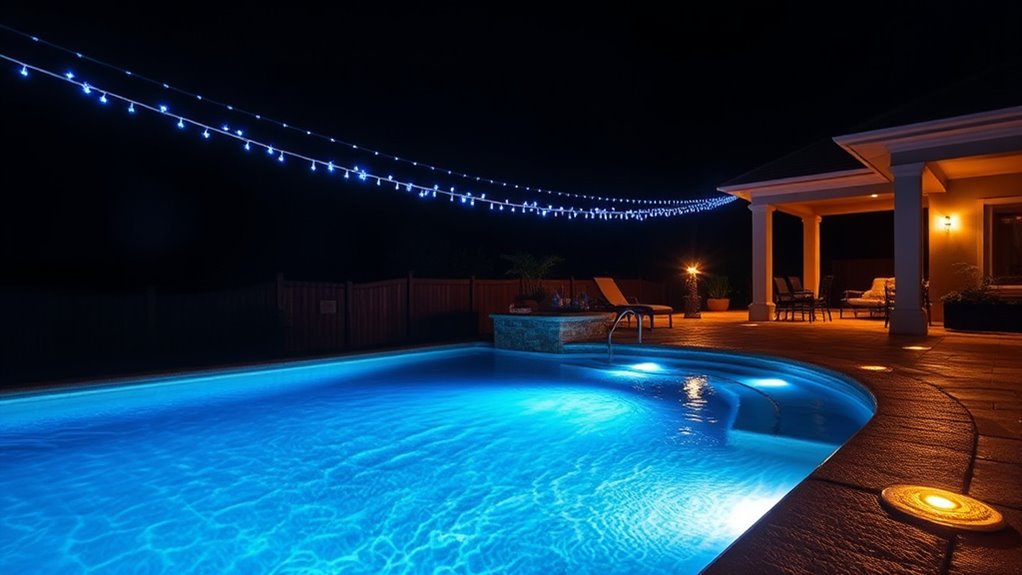
Thinking about lighting your pool? You’re probably considering different options that can enhance your backyard oasis while also being practical. When choosing the right pool lighting, factors like lighting color and energy efficiency play vital roles. LED lights are a popular choice because they offer a wide variety of colors, allowing you to customize your pool’s ambiance. With adjustable lighting colors, you can set the mood for a romantic evening, a lively pool party, or a calming night swim. Plus, LED lights are incredibly energy-efficient, consuming considerably less power than traditional options. This means lower electricity bills and a greener footprint, which is beneficial if you’re conscious of your environmental impact. LEDs also have a longer lifespan, reducing maintenance and replacement costs over time.
Fiber optic lighting provides a stunning, almost magical effect by transmitting light through thin strands of glass or plastic. You won’t find a better way to create a sleek, modern look with vibrant lighting colors that can be changed easily. Fiber optics don’t generate heat, so they’re safer for underwater use and won’t affect your pool’s chemistry. They’re also highly energy-efficient because they transmit light directly to where it’s needed without much loss, helping you save on energy costs. However, fiber optic systems can be more complex to install initially and might require a bit more maintenance to keep the fibers clean and functioning properly. Still, their ability to produce crisp, colorful effects makes them a favorite for those wanting a unique and customizable pool experience. Additionally, advances in lighting technology continue to improve the ease of installation and maintenance for fiber optic systems.
Halogen lighting has been a traditional choice for pool illumination for many years. They produce a warm, bright glow that enhances the natural beauty of your pool and surroundings. While halogen lights tend to consume more energy, they are generally less expensive upfront than LEDs or fiber optics. Their lighting color is typically limited to warmer tones, which might not be as versatile as LED or fiber optic options. Over time, halogen bulbs burn out more quickly and need replacing, which can add up in maintenance costs. Despite this, some homeowners prefer halogen for its simplicity and proven reliability, especially if they’re seeking a straightforward, cost-effective lighting solution without too many bells and whistles. When considering long-term savings, energy-efficient lighting options like LEDs can be more economical despite higher initial costs.
In the end, your choice depends on what you value most—whether it’s the vibrant lighting colors and energy efficiency of LEDs, the sleek, customizable effects of fiber optic lighting, or the traditional warmth of halogen lights. Each option offers unique benefits and considerations, so weigh your priorities carefully to create a stunning, functional pool lighting setup that elevates your outdoor space.
Frequently Asked Questions
Which Pool Lighting Option Is Most Energy-Efficient?
You’ll find that LED pool lighting is the most energy-efficient choice. It consumes less energy, reducing your overall energy bills and lowering environmental impact. LEDs use less power than fiber optic or halogen options and last longer, making them a sustainable choice. By choosing LED lighting, you’re not only saving money but also helping protect the environment through reduced energy consumption.
How Long Do LED Pool Lights Typically Last?
Think of your LED pool lights as a reliable lighthouse guiding you through many seasons; they typically last 50,000 hours, or about 10-15 years with regular use. You can enjoy vibrant color customization without worrying about frequent replacements. Installation complexity is usually minimal, making them an easy upgrade. So, you get long-lasting illumination and flexible design options, ensuring your pool stays beautifully lit for years to come.
Are Fiber Optic Lights Safe for All Pool Types?
Fiber optic lights are generally safe for all pool types when properly installed and maintained. Their safety depends on fiber optic safety standards and ensuring your pool’s specific setup is compatible. You should check with the manufacturer or a professional installer to confirm pool type compatibility. As long as you follow safety guidelines and choose quality products, fiber optic lighting offers a safe, visually appealing option for your pool.
Can Halogen Lights Be Used Underwater Safely?
Like Icarus soaring too close to the sun, you might wonder if halogen lights can be safely submerged. The truth is, with proper waterproof fixtures and installation, halogen lights can be used underwater securely. They offer good durability, especially when designed for underwater use. However, ensure they’re rated for underwater safety and follow manufacturer instructions to prevent accidents. Proper installation guarantees both safety and long-lasting performance.
What Maintenance Is Required for Different Pool Lighting Types?
For pool lighting maintenance, you need to regularly check your bulbs for signs of wear and perform pool bulb replacement when they burn out. You should also monitor water chemistry effects, as improper pH levels and chemicals can damage lights and diminish their lifespan. Keep your fixtures clean and inspect wiring for corrosion or damage, especially with halogen and fiber optic lights, to guarantee safe, effective operation.
Conclusion
Choosing the right pool lighting is like picking the perfect star for your night sky—each option has its unique glow. LED, fiber optic, and halogen lights all bring their own charm, so consider your style, budget, and how you want your pool to shine. With the right choice, your pool becomes a mesmerizing oasis, turning every swim into a magical experience. Light up your nights and let your pool’s beauty shine brighter than ever.
